
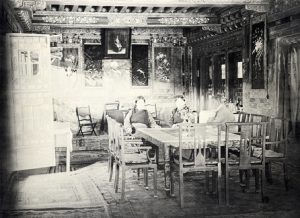


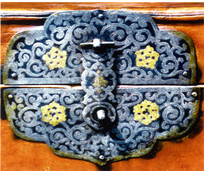
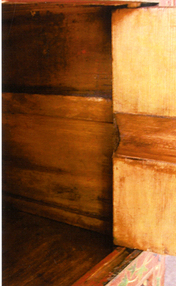



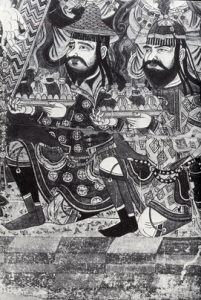

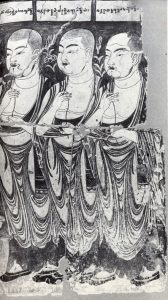

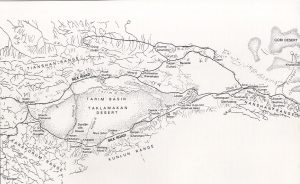
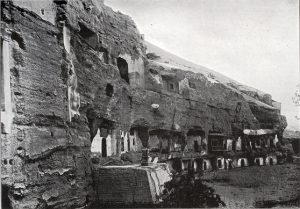

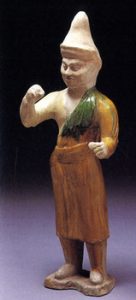

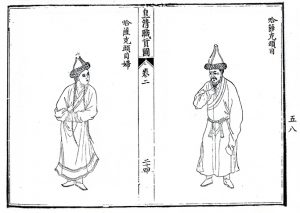




Louis Ho

Cabinet. Tibet, 19th century. Painted wood, H 39 in. (100.3 cm).
Mr. and Mrs. C. Suydam Cutting Bequest Funds and The Members’ Fund, Newark Museum.
Acc. No. 90.365
Tibetan Furniture

Tsarong family—one of the wealthiest families in Tibet—in their house in Lhasa, 1936-7. The Tsarong house was probably the only dwelling in Tibet with a room decorated with Western-style furniture. Rinchen Dolma Taring, the woman at left, sister of the wife of the man at right, emigrated to London, where she published “Daughter of Tibet” in 1970.
The wooden cabinet (Tib. chagam), above, in the collection of the Newark Museum, dates from the 19th century. [1] Cabinets as an item of furniture did not become popular in Tibet until the 18th, for reasons yet unclear – the centuries-old trade with China would surely have exposed Tibetans to Chinese examples – but the increased settlement and rising affluence of the local populace during the period have been adduced as possibilities. [2] Its physical heft and added expense of production ensured that the chagam was one of the few non-portable pieces in a domestic or monastic space; the more lavishly decorated pieces would not have been out of place in a wealthy, urban household like the one captured in the photograph above. [3] Tibetans, if they made a traditional living as nomadic or semi-nomadic herdsmen, required furniture that could move with them, like the ubiquitous storage chest, or gam, which served a variety of purposes, and the low table (chogtse), used for meals and tea-drinking, and which could be folded up and put aside afterward. Examples of both, in an outdoor setting, can be seen in the picture directly below. [4] In general, common Tibetan furniture items would also have included special desks for reading and writing (pegam); wooden altars or shrines (choshom) used to house Buddhist icons (in the photograph below [5]); yangam, for the yangbum, or wealth vases, believed to bring happiness and prosperity; and offering cabinets, torgam, for ritual oblations, often found in the gon-khang of a temple.

Three abbots and a lama from eastern Tibet, about 1930.

The physician (am-chi) of Gyantse, with his large cow-boy hat decorated with a golden plate, in front of his home altar. Those items that look like cushions, high above his head, are books wrapped in silk cloth. On the upper left side we see half of a colorful banner (thangka) with a painted image from the “Tibetan Book of the Dead.”
Chagams

 Wood for construction purposes was available in the highlands of the central Tibetan plateau (where the largest urban hubs, Lhasa and Shigatse, are located), but this was a local softwood referred to as chapa; it was the timber of the spruce, pine and fir trees found in the forests of the eastern province of Kham that was prized by furniture makers. [6] Most likely constructed from one of these quality hardwoods, the Newark chagam displays the frame-and-panel style typical of Tibetan cabinets: doors and – sometimes – sides are composed of discrete panels set into an enframing structure, creating a visual effect not unlike that of a coffered surface. Here, each of the four doors is hinged with wooden dowels, or connective pegs (above), which attach the top and bottom of the door to its frame, allowing it to swing open and shut. The doors were originally fastened around the central decorative brass loop by a metal plate (of the sort seen at right) and a lock, both now presumably lost. [7]
Wood for construction purposes was available in the highlands of the central Tibetan plateau (where the largest urban hubs, Lhasa and Shigatse, are located), but this was a local softwood referred to as chapa; it was the timber of the spruce, pine and fir trees found in the forests of the eastern province of Kham that was prized by furniture makers. [6] Most likely constructed from one of these quality hardwoods, the Newark chagam displays the frame-and-panel style typical of Tibetan cabinets: doors and – sometimes – sides are composed of discrete panels set into an enframing structure, creating a visual effect not unlike that of a coffered surface. Here, each of the four doors is hinged with wooden dowels, or connective pegs (above), which attach the top and bottom of the door to its frame, allowing it to swing open and shut. The doors were originally fastened around the central decorative brass loop by a metal plate (of the sort seen at right) and a lock, both now presumably lost. [7]
Tibetan Art & Tibetan Crafts

Gyantse. Tibetan woodpainters, shing tsonpo, decorating Tibetan tables, now in the Museum of Ethnography Munich.
Lavishly-decorated furniture pieces like the chagam were often the result of a special commission from an atelier, among the members of which could be counted a decorator, or tsönpa (above) [8], so designated to distinguish him from a painter of thangkas and murals (below). [9] The lively, winsome scenes depicted on the doors, so seldom encountered in the context of Tibetan art, lend it much of its visual appeal, especially for a Western viewership, where both institutional and private collections have tended to focus on objects with a religious or spiritual bent. As one commentator puts it: “In the western art world, the word ‘Tibetan’ has come to be directly associated with Buddhist scroll paintings – thangka – and statues … These religious and traditional items have already made inroads into the lucrative Asian antiques market as well as the public museum culture of the US and Europe.” [10] This bias, unsurprisingly, both informs and is influenced by similar trends in academia:
While Tibetan religious artwork has earned a prominent place in museum collections, exhibitions, and among Asian art scholars and even the fashionable public, Tibetan furniture has attracted comparatively little academic or amateur attention. The uncontested artistry and refinement inherent in the paintings and statuary of Tibetan religious expression are often strictly governed by scripture and treatise, not to mention tradition, in matters of composition, proportion, use of color and subject. In contrast, Tibetan furniture has long provided a much more liberated canvas for the artisan and artist alike, showcasing decorative motifs based not only on the religious, but also on the secular and natural. Perhaps for this reason, furniture and its decoration have often been overlooked and left largely untouched as an academic topic by art historians and Tibetologists. Nonetheless, these often ingeniously practical pieces offer a rare glimpse into the full range of Tibetan artistic expression, frequently boasting decoration that incorporates the aesthetics and motifs of other, more familiar media. [11]
As the above passage suggests, a distinction is or was made between the ‘high’ art forms of thangka and mural, with their appropriately religious subject matter, and ‘low’, decorative media, relegated to the adornment of objects of utility. Most discussions of Tibetan painting limit themselves to particular formats; the characterization, by one of the chief scholars in the field, of “three [main] types of Tibetan painting—thankas, illustrations for manuscripts and their covers, and murals” typifies the standard approach. [12] Although the juxtaposition of disparate stylistic modes and subject matter on the Newark cabinet is rather unrepresentative, what these paintings perhaps present is a complementary view on the normative discourse of, and on, Tibetan artistic traditions, even if they are characterized as no more than a “charming Tibetan genre style”, located on the peripheries of the established canon. [13]
However, the designation of the object as Tibetan is not without debate: it may well have been that it was produced in China by Chinese artists in a Tibetan style, rather than the other way round [14], an assumption made by both the Newark Museum and the present author. Especially in the case of Tibetan art, where cross-cultural currents with its neighbours have long flowed both ways, unproblematic demarcations based on geography and style can prove elusive:
The fact is, it is sometimes hard to tell the difference. If a Tibetan artist, working in China, uses a silk ground … that is adapted to Tibetan tastes from a Chinese model, which itself may have been inspired by Tibetan imagery, is it Tibetan or is it Chinese ? If, by contrast, an artist uses the cotton ground generally found in Tibet to paint … according to a Tibetan composition, but using brushwork we credit to Chinese painting, can we be sure it is (not) Tibetan? The artist’s ethnic identity, the place of production, materials, painting style, and largely unrecorded history of the evolution of compositions make it challenging to attribute some of these paintings with confidence. [15]
As such, the following discussion is presented as an exploration of possible visual sources, a truncated topography of the larger artistic universe that was inhabited by the makers of the Newark cabinet, and is less concerned with establishing definitive conclusions, a goal that remains at present beyond the scope of this project. In attempting to read the object, it is worth bearing in mind Roland Barthes’—oft-cited but valuable—declaration that the text is a “multidimensional space”, a “tissue of quotations drawn from the innumerable centers of culture.” [16]

The thirteenth Dalai Lama’s favored artist painting a tangka, 1937. His long earring identifies him as a lay official
First Panel: Tibet & Its Others
 The scenes, beginning clockwise from the upper left, have been identified as: Central Asians and Qing officials gambling and eating in the garden of a Lhasa nobleman (left); a Chinese gentleman hosting a party at which a magician is conjuring up coins and celestial beings; the Chinese patron and sage Hva-shang; and, lastly, frolicking horses in a Tibetan landscape. [17] The first of these is notable chiefly for the racialization of its figures: Central Asia, the region once known as Turkestan and today the Chinese province of Xinjiang, came under Tibetan sway from the eighth to ninth centuries. [18] The representation of foreigners, especially those of Indic or Sinic stock, occur frequently in Tibetan art – the latter here sporting the Manchu queue – but the ochre-tinted complexion, overt swarthiness and superior height of the standing figure attest to a rather different racial type, the sort of Caucasoid physiognomy witnessed in the murals of Bezeklik, for instance (below left) [19], as well as in the famous sketchbook of the Newari artist Jivarama, of which more will be said later (below right) [20]. Bezeklik, a complex of grottoes on the northern route of the Taklamakan desert, situated between the cities of Turfan and Loulan, was once resplendent with exquisite Buddhist wall paintings. The German explorer Albert von Le Coq [21] became the first European to visit it in 1904-5, whereupon he proceeded to systematically strip the caves of their painted treasures, a course of action that was to end in tragedy for these works of art during the Allied blitz of Berlin in World War II. What he took home with him to Germany was considered unusual indeed:
The scenes, beginning clockwise from the upper left, have been identified as: Central Asians and Qing officials gambling and eating in the garden of a Lhasa nobleman (left); a Chinese gentleman hosting a party at which a magician is conjuring up coins and celestial beings; the Chinese patron and sage Hva-shang; and, lastly, frolicking horses in a Tibetan landscape. [17] The first of these is notable chiefly for the racialization of its figures: Central Asia, the region once known as Turkestan and today the Chinese province of Xinjiang, came under Tibetan sway from the eighth to ninth centuries. [18] The representation of foreigners, especially those of Indic or Sinic stock, occur frequently in Tibetan art – the latter here sporting the Manchu queue – but the ochre-tinted complexion, overt swarthiness and superior height of the standing figure attest to a rather different racial type, the sort of Caucasoid physiognomy witnessed in the murals of Bezeklik, for instance (below left) [19], as well as in the famous sketchbook of the Newari artist Jivarama, of which more will be said later (below right) [20]. Bezeklik, a complex of grottoes on the northern route of the Taklamakan desert, situated between the cities of Turfan and Loulan, was once resplendent with exquisite Buddhist wall paintings. The German explorer Albert von Le Coq [21] became the first European to visit it in 1904-5, whereupon he proceeded to systematically strip the caves of their painted treasures, a course of action that was to end in tragedy for these works of art during the Allied blitz of Berlin in World War II. What he took home with him to Germany was considered unusual indeed:
 Continuing their advance along the corridor they next brought to light from beneath the sand fifteen giant-sized paintings of Buddhas of different periods. Other figures, shown kneeling before the Buddhas offering gifts [right], were of particular interest to von Le Coq since they depicted individuals of different nationalities. They included Indian princes, Brahmins, Persians – and one puzzling character with red hair, blue eyes and distinctly European features. [22]
Continuing their advance along the corridor they next brought to light from beneath the sand fifteen giant-sized paintings of Buddhas of different periods. Other figures, shown kneeling before the Buddhas offering gifts [right], were of particular interest to von Le Coq since they depicted individuals of different nationalities. They included Indian princes, Brahmins, Persians – and one puzzling character with red hair, blue eyes and distinctly European features. [22]



Dunhuang: Chinese connections
The site of Dunhuang was an important stop along the Silk Road: it opened up into the Hexi Corridor, the main artery leading from the Gobi desert into the Central Plains proper, and its position at the geographical juncture of various cultures is reflected in the rich


Rows of small Buddhist cave-temples seen from the shrine of a colossal Buddha, in southern group of ‘Thousand Buddhas’ site, Tun-huang.

Central Asia & China


The figure of the hirsute Central Asian in his distinctive peaked hat (among other models) appears to have been based on real-life examples, eventually becoming a stock image in Chinese visual culture. Often pictured with their animals, frequently camels, which were their livelihood as well as main mode of transportation over the Silk Road, whither they came to trade with the Middle Kingdom, these foreigners were referred to using the umbrella term hu-ren (胡人), a designation for the various northern and western tribes beyond the pale of Chinese civilization. and has preserved some early depictions (above) of these peoples. [23] Numerous examples in the characteristic three-colour (sancai, 三彩) ware of the Tang Dynasty, produced during an era when the Silk Road was at its height, are also extant (right). This image of the Central Asian persisted well into later generations, as can be witnessed in the woodblock prints below, culled from an illustrated compendium of “Imperial Qing Pictures of Tributaries” produced during the reign of the Emperor Qianlong: the male figure is identified as a Kazakh chieftain (ha sa ke tou mu). [24]

Iconic Circuits
A useful concept to introduce at this point might be that of the iconic circuit. [25] Itself a borrowed term, Sinologist and art historian Craig Clunas deploys the idea as a means of describing movement and exchange within a “visual economy”: the different incarnations of a particular image or scene throughout a variety of media, the chief advantage of which is that, like “any sort of enquiry based broadly on a ‘visual culture’ paradigm”, it “sidesteps the painting/not-painting division and allows an engagement with the pictorial in whatever physical forms it is produced and however it is viewed and consumed.” [26] In what may be seen as an example of this sort of circulation, a group of Kazakhs are shown presenting horses to Qianlong (below), their physical and sartorial appearance recalling other like depictions. The painting was the work of the expatriate Jesuit priest, Giuseppe Castiglione, aka Lang Shining (郎世宁), who found favour at the Qing court and subsequently produced numerous depictions of local subjects in a style that introduced Western modes of verisimilitude into Chinese painting. His rendition signals perhaps a shift from one medium to another, from one register, printed matter intended for wider distribution and consumption, as printed books were, to another, elite painting issuing from the imperial atelier, and vice versa. Qianlong’s court was by all accounts a truly international affair: besides Castiglione, the ties between Beijing and Lhasa at this time—political, religious, artistic—was embodied in the person of the emperor’s preceptor, Rolpay Dorje, a Tibetan lama who wielded tremendous prestige and exerted great influence over his royal patron. [27]

Second Panel: Chinese New Year Prints
 The second panel (left) marks a departure from its brethren: its subject matter and style suggest that the artist was looking directly to Chinese woodblock prints for inspiration, and may indeed have been a replacement for an original door. [28] Similar scenes can be found in that genre commonly referred to as New Year pictures, or nian hua (年画), the earliest examples of which may be traced back to the Zhou Dynasty (841 – 256 BCE), when designs of animals like tigers were pasted onto the gates of domiciles as apotropaic talismans during the Lunar New Year. Two manuals attributed to the Song Dynasty statesman, scientist and polymath Shen Kuo (1031 – 1095 CE), the Bu Bi Tan (补笔谈) and Dong Jing Meng Hua Lu (东京梦华录), preserve early written records of such pictures, images of door gods, peach-wood amulets and the mythological demon-catcher Zhong Kui that, according to the author, were available in the marketplace during the festive period. [29] The late Qing prints below, hailing from the northern town of Yangliuqing, today a suburb of the city of Tianjin, depict the acquisition of wealth—a theme, signaling good fortune, that was common enough at New Year’s. The first features the phrase si fang jin bao (四方进宝) on the red plaque hanging above the altar, or ‘treasure enters from all four directions’; the second, zhen shi huo cai shen lai dao zha jia (真是活财神来到咱家), ‘a living god of wealth has indeed come to our home’. Like the chagam panel, these prints include the auspicious motifs of the visitation of deities, and the magical appearance or bestowal of riches (in the form of ingots and taels), the latter conspicuously aglow with enchanted luminescence or flames.
The second panel (left) marks a departure from its brethren: its subject matter and style suggest that the artist was looking directly to Chinese woodblock prints for inspiration, and may indeed have been a replacement for an original door. [28] Similar scenes can be found in that genre commonly referred to as New Year pictures, or nian hua (年画), the earliest examples of which may be traced back to the Zhou Dynasty (841 – 256 BCE), when designs of animals like tigers were pasted onto the gates of domiciles as apotropaic talismans during the Lunar New Year. Two manuals attributed to the Song Dynasty statesman, scientist and polymath Shen Kuo (1031 – 1095 CE), the Bu Bi Tan (补笔谈) and Dong Jing Meng Hua Lu (东京梦华录), preserve early written records of such pictures, images of door gods, peach-wood amulets and the mythological demon-catcher Zhong Kui that, according to the author, were available in the marketplace during the festive period. [29] The late Qing prints below, hailing from the northern town of Yangliuqing, today a suburb of the city of Tianjin, depict the acquisition of wealth—a theme, signaling good fortune, that was common enough at New Year’s. The first features the phrase si fang jin bao (四方进宝) on the red plaque hanging above the altar, or ‘treasure enters from all four directions’; the second, zhen shi huo cai shen lai dao zha jia (真是活财神来到咱家), ‘a living god of wealth has indeed come to our home’. Like the chagam panel, these prints include the auspicious motifs of the visitation of deities, and the magical appearance or bestowal of riches (in the form of ingots and taels), the latter conspicuously aglow with enchanted luminescence or flames.


(Of limited interest might be a real-life example preserved in its original context at the Peabody Essex Museum: Yin Yu Tang (荫余堂) was the multi-generational dwelling of a prosperous merchant clan located in southern Anhui province, the stone and timber structure now transported to and re-erected in its entirety at the PEM. On a door within the complex survives a much faded woodblock print that, according to its description on the museum’s website, “depicts two plump boys, and reflects a desire for healthy sons to carry on their family line, a recurrent New Year theme …”
See http://www.pem.org/yinyutang/. Click on “Explore House”, and “Proceed”. Choose “Ornamentation”, then “Scene 15: New Year’s Poster (1800s)”, by either clicking on the little arrows to move forward, or skipping ahead by selecting a little transparent box under the title “Ornamentation”, in the top left-hand corner of the screen. [30])
Third Panel: Hva Shang

 The bottom pair of panels likewise present interesting studies. The one on the left portrays Hva Shang – whose name is a transliteration of the Chinese term for a monk, he-shang (和尚) – considered the Chinese patron of the 16 Arhats. Historical accounts tell us that he was sent by Tang emperor to extend an invitation to the Buddha Shakyamuni, but, the latter having already passed on, addressed himself to the arhats instead. Hva Shang is usually portrayed as a bald, portly figure, seated beneath or beside a flowering tree with a rosary in his right hand and an offering to the arhats in the left, and frequently surrounded by cavorting children and one or more Buddhist deities. [31] Giuseppi Tucci writes:
The bottom pair of panels likewise present interesting studies. The one on the left portrays Hva Shang – whose name is a transliteration of the Chinese term for a monk, he-shang (和尚) – considered the Chinese patron of the 16 Arhats. Historical accounts tell us that he was sent by Tang emperor to extend an invitation to the Buddha Shakyamuni, but, the latter having already passed on, addressed himself to the arhats instead. Hva Shang is usually portrayed as a bald, portly figure, seated beneath or beside a flowering tree with a rosary in his right hand and an offering to the arhats in the left, and frequently surrounded by cavorting children and one or more Buddhist deities. [31] Giuseppi Tucci writes:
Hva šan is the Tibetan transcription of the Chinese Ho shang, which in its turn transcribes, through a Central Asian medium, the Sanskrit title: upādhyāya; this naturally recalls to our memory that Hva šan who, in the times of King K’ri sron lde btsan, while Padmasambhava’s schools introduced currents of Indian thought from India, carried into Tibet echoes of Chinese Buddhism.
But, while Tibetan literary tradition follows the Indian one or draws its inspiration from it, the artistic representation of this cycle is under Chinese influence. And in reality this influence has been so strong, that it is almost invariably to be found in the pictorial or plastic representations of the arhats; only a few exceptions being known to this rule. [32]

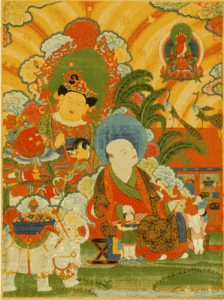

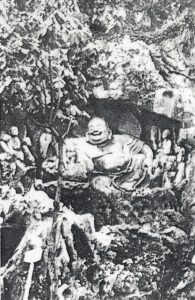

The Newark chagam departs little from this iconographic formula: the rosary, offering, and children, and even a couple of elephants are included. This last, though the last not typically part of the standard stock of attributes, finds a parallel in a Bhutanese painting, one of a set of 11 (below). [32] Unlike the elephants on the panel, which neither engage with the other figures nor seem be included in the main tableaux, cut off as they are by a line indicating a break in the landscape, the white elephant here, “carrying a dish of treasures, led by a turbaned mahout, offers a white conch on his trunk” to Hva Shang.

Jivarama’s Sketchbook

Budai: the Transmission & Transformation of an Image



It is chiefly in the treatment of the tree, however, that the artist seems to have exercised some creative license. The luxuriant canopy of small, almost identical blooms stretches across the full length of the compositional space at the top, forming a wall of floral foliage. A quick comparison with a Hva Shang scroll of Sakya lineage (left), dating to the 16th century, reveals how the present painting differs in this respect, the former allowing the person of the monk himself to dominate visually, the tree partially obscured by virtue of occupying the space behind him; another 18th century thangka (right) depicts two blooming shrubs which, again, remain pictorially subordinated in terms of size and interest, hardly allowed to detract from the chief figure. [27] The flowers on the Newark panel, in their lush, sumptuous patterning, approach the quality
1. See Valrae Reynolds, From the Sacred Realm: Treasures of Tibetan Art from the Newark Museum (Munich & New York: Prestel Verlag, 1999), p. 94, for a short discussion of the object.
2. Chris Buckley, Tibetan Furniture (Connecticut: Floating World Editions, 2005), p. 37.
3. Photograph by Frederick Spencer-Chapman, reproduced in Lobsang P. Lhalungpha (chronicle), Tibet, the Sacred Realm: Photographs 1880 – 1950 (New York: Aperture, Inc., 1983), p. 109. All accompanying captions are taken from their respective texts, as noted.
4. Photograph by Leslie Weir, reproduced in Tibet, the Sacred Realm, p. 102.
5. See Fosco Maraini, Prima Della Tempesta: Tibet 1937 e 1948 (Arcidosso, GR [Italy]: Shang-Shung Edizioni, 1990), plate. 48. Thanks to Dr. Ramon Prats of the Rubin Museum of Art for the translation of the text from the original Italian.
6. Luce Corona and Camilla Hulse Corona, “Tibetan Furniture: Construction, Form and Function” in Wooden Wonders: Tibetan Furniture in Secular and Religious Life, ed. David Kamansky (Pasedena & Chicago: Pacific Asia Museum & Serindia Publications, 2004), p. 25.
7. See Reynolds, p. 94.
8. See Isrun Engelhardt, ed, Tibet in 1938 – 1939, Photographs from the Ernst Schäfer Expedition to Tibet (Chicago: Serindia Publications Inc., 2007), plate 141, p. 229.
9. Photograph by C. Suydam Cutting, reproduced in Tibet, the Sacred Realm, p. 108. “The thirteenth Dalai Lama’s favored artist painting a tangka, 1937.
10. See Kabir Mansingh Heimsath, “Untitled Identities: Contemporary Art in Lhasa, Tibet”, Asianart.com, http://www.asianart.com/articles/heimsath/index.html.
11. Jonathan Bell, “Some Links Between Tibetan Furniture, Wall Mural and Thangka Painting”, in Kamansky, p. 61.
12. Pratapatidya Pal, Art of Tibet: a Catalogue of the Los Angeles County Museum of Art Collection (
13. Reynolds, p. 94.
14. Thanks to Prof. Gray Tuttle for pointing this out.
15. Rob Linrothe, Paradise and Plumage: Chinese Connections in Tibetan Arhat Painting (New York: Rubin Museum of Art, & Chicago: Serindia Publications, 2004), pp. 11-12.
16. Roland Barthes, “The Death of the Author”, in Image, Music, Text (New York: Noonday Press, 1988), p. 146.
17. Reynolds, p. 94.
18. For a discussion of this history, and artistic similarities between the two regions, see Marilyn Rhie, “Seventh-Century Monumental Sculpture in the Tsang region” in Tibetan Art: Towards a Definition of Style, ed. Jane Casey Singer and Philip Denwood (London: Laurence King Publishing, 1997), pp. 38-51.
19. Reproduced in Rhie, p. 41. The mural, according to the text, is from Cave 20 at Bezeklik (Le Coq’s Temple 9).
20. The sketchbook is discussed, and reproduced in its entirety, in John Lowry’s “A Fifteenth Century Sketchbook (Preliminary Study)” in Essais sur l’art du Tibet, ed. Ariane MacDonald and Yoshiro Imaeda (Paris: Librairie d’Amérique et d’Orient, 1977), pp. 83-118. See p. 104 for the leaf in question.
21. See Albert von Le Coq’s account, Buried treasures of Chinese Turkestan: an Account of the Activities and Adventures of the Second and Third German Turfan Expeditions, trans. Anna Barwell (London, Allen & Unwin, 1928).
22. Peter Hopkirk, Foreign Devils on the Silk Road (Amherst: The University of Massachusetts Press, 1980), p. 126.
23. Li Xiao Bing 李肖冰, Zhongguo xiyu minzu fushi yanjiu 中国西域民族服饰研究 (Research into the costumes of China’s western regions) (Urumqi: Xinjiang renmin chubanshe, 1995), p. 225.
24. Liu Tuo 刘托 and Meng Bai 孟白, ed., Huang Qing zhigong tu 皇清职贡图 (Pictures of Imperial Qing tributaries), Qing dian banhua huikan 清殿版画汇刊, no. 9 (Beijing: Xueyuan chubanshe, 1998), fig. 58.
25. See Craig Clunas, Pictures and Visuality in Early Modern China (London: Reaktion Books, 1997), pp. 41-9, for a treatment of this idea.
26. Clunas, p. 48.
27. See Patricia Berger, Empire of Emptiness: Buddhist Art and Political Authority in Qing China (Honolulu: University of Hawaii Press, 2003), for a detailed examination of Dorje’s role, as well as Tibetan stylistic influences on Qing visual culture of the period.
28. Noted by Dr. Karl Debreczeny of the Rubin Museum of Art. His help in tracking down sources is particularly appreciated.
29. Junzhou Zhu’s 祝均宙 Preface in Qing mo nianhua huicui 清末年画汇萃 (Anthology of Late Qing New Year Pictures) (Beijing: Renmin yishu chubanshe, 2000), p. 7. The prints are reproduced as plates 55 and 56.
30. See also Nancy Berliner’s Yin Yu Tang: The Architecture and Daily Life of a Chinese House (Vermont: Tuttle Publishing, 2003).
31. Jeff Watt’s entry dated 6-98, “Arhat: Hvashang (patron)”, Himalayan Art Resources, http://www.himalayanart.org/search/set.cfm?setid=217&page=1.
32. Tucci …
32. See Terese Tse Bartholomew and John Johnston, ed., The Dragon’s Gift: The Sacred Arts of Bhutan (Chicago: Serindia Publications, 2008), pp. 182-7, for a discussion of the set. The catalogue accompanies the travelling exhibition.
